Students of Azerbaijan Democratic Republic abroad
Students of Azerbaijan Democratic Republic abroad or Republic students (Azerbaijani: Cümhuriyyət tələbələri), were students sent by the government of Azerbaijan Democratic Republic (ADR) at the beginning of 1920 to study in higher educational institutions of Western Europe, Russia and Turkey. In total, about 100 students from various strata of society were sent,[2] for which 7 million rubles were allocated to the Ministry of Public Education.[3]
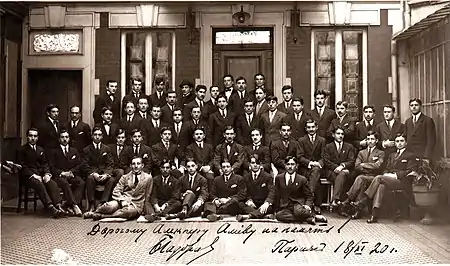
After the fall of the Azerbaijan Democratic Republic and the Sovietization of the country due to the Red Army invasion of Azerbaijan, students continued their education. Upon completion, many returned to Azerbaijan and achieved significant success. Some even received government awards, including the Order of Lenin.[2] Notable individuals among them include Ahmed Rajabli, Aslan Vezirzade, Ashraf Aliyev, Samandar Akhundov, and Teymur Aslanov.
However, many of them were repressed by the NKVD in the 1930s on charges of spying for Germany and supporting the restoration of Azerbaijan's independence.[2]
Decision to send students abroad
By the end of 1919, the government of the Azerbaijan Democratic Republic had implemented a number of educational reforms: textbooks for primary and secondary schools were published, seminaries were opened in various regions of country, Baku State University was founded, and a law was passed on the creation of an agricultural university.[2] Not limited to opening a university, the government was looking for ways to train the necessary specialists, in particular, sending Azerbaijani youth abroad for higher education.[4] Despite the difficult military-political situation, it was decided to send Azerbaijanis abroad to study at European universities.[2] Mammad Emin Rasulzade, listing the achievements of Azerbaijan, noted:
To obtain higher education in various fields of knowledge – from architecture and ethnology to aircraft and shipbuilding, about 100 Azerbaijani students at the expense of the state were sent to the best European educational institutions[2]
Parliament Decree
In the summer of 1919, the Ministry of Education proposed a bill to allocate 4 million rubles for the 1919–20 academic year. This funding was intended to support 100 students studying abroad, with each student receiving an allotment of 36.5 thousand rubles. Upon completion of their studies, these students were obligated to serve in Azerbaijan's civil service for a minimum of two years.[4] Students who were recipients of a government scholarship had an additional requirement to work for four years in a government-assigned role post-graduation.[3]
On 1 September 1919, the parliament decided:
- to allocate 7 million rubles from the state treasury to the Minister of Public Education. This funding was intended for the purpose of sending one hundred applicants to foreign higher educational institutions for the 1919–20 academic year.
- students who receive a state scholarship are required to serve for four years in a position designated by the government after graduation.[4]
In relation to this, the parliament emphasized: "In order to ensure the well-being and success of the students, a system of supervision must be established over them."[5]
Organizational matters
When discussing this bill back in the summer of 1919, there were controversies in parliamentary factions over sending students from wealthy families abroad. According to many MPs, the number of students should have included mainly representatives of the poor, and the sons of wealthy families should have had to study at their own expense.[4] The selection was made among various segments of the population, its main criterion was only the giftedness of the citizens of the young republic.[2] One of the selected students, repressed by the NKVD after returning Azerbaijan.
There was a proposal to send young men from wealthy families to study, but the student committee created at that time, headed by Mammad Gulu Ganja, supported the candidacies of poor families in need of state support.[2]
As a result, "people of both wealthy and poor" were sent to study.[2]
On 15 September 1919, a meeting of parliament was held on the issue of state scholarships for students traveling abroad. The meeting was attended by Mammad Amin Rasulzade, Mehdi bey Hajinski, Ahmad bey Pepinov, Gara bey Garabeyov, Abdulla bey Efendiyev, Aynul Usubbekova, Behbud Khan Javanshir, Neymatulla bey Shakhtakhtinsky, Samandar Akhundov and representative of the Baku committee of Muslim students, Mammadgulu Hajinsky.[5]
A commission was also created to organize the sending and distribution of students.[5] Even before the parliament passed a resolution on sending students, in the summer of 1919, the "Ittihad" and "Ahrar" factions proposed that half of the people go to the faculties of history, philology, natural sciences, physics and mathematics in order to return home as teachers of secondary educational institutions.[4] But according to their specialties, students were distributed as follows: natural science – 8, medicine – 8, mining – 7, mechanics – 11, chemistry – 3, electrical engineering – 8, construction – 4, aviation – 2, agronomy – 3, economics – 5, history and philology – 5, philosophy – 7, legal sciences – 6, political science – 3. By that time, the commission received 280 applications. The advantage in selection was enjoyed by those who knew the Azerbaijani language ("Turkic" in the terminology of that time) and the language of the country where the student was sent, who had certificates with a high score, and also poor.[5]
Departure of students
Final preparations
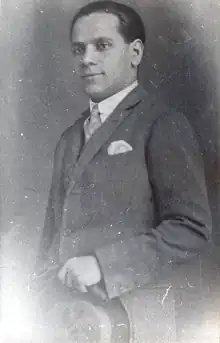
The students who were sent abroad elected a bureau of five members to assist the commission in organizing their departure. Teymur Aslanov was chosen as the chairman of the commission and, along with Shakhtakhtinsky, traveled to Tiflis and Batumi to secure the necessary passes. To provide for the students' needs, the bureau petitioned the Ministry of Trade and Industry to supply each student with 40 arşın (28.4 metres (93 ft)) of linen, two pairs of sheets, two pairs of towels, and half a dozen scarves, amounting to 2,000 rubles, as well as tea and sugar. The Ministry approved this request.[5]
On December 12, 1919, the commission decided to enroll 100 people as state scholarship recipients. Due to inflation, the stipend was increased from 400 to 500 francs, with an additional 200 francs allocated for the purchase of uniforms. Consequently, the Ministry of Finance issued each student a total of 2600 francs.[6]
Departure
The first group of students embarked on their journey via express train on January 14, 1920. Several members of parliament, including Mammad Amin Rasulzade, Ibrahim Abilov, Samad aga Agamalioglu, Aslan bey Safikurdski, Abbasqulu Kazimzade and Ahmed bey Pepinov, were present to bid them farewell. Rasulzade delivered a parting speech on behalf of the Musavat party, Abilov represented the Social Democratic Party, and Safikurdski spoke for the Khalgchi social revolutionaries. Other speakers included Samad aga Agamalioglu, Piri Mursalzade, Abbasqulu Kazimzade, and more. The speakers wished the students success in their studies and encouraged them to apply their acquired knowledge to the prosperity of their homeland upon their return, as there was a pressing need for educated specialists at the time. Speaking on behalf of the government, Minister of Agriculture Ahmed bey Pepinov assured the students that the government would spare no expense necessary for their studies abroad.[6]
The students then settled into a carriage that had been prepared for them, its doors adorned with the flags of Azerbaijan. From within the carriage, the melodious strains of the tar and the singing of "Segah" could be heard, punctuated by enthusiastic cries of "Long live Azerbaijan!" (Azerbaijani: Yaşasın Azərbaycan!).[6]
During their journey, the students were warmly welcomed at various stops along the way, including Kurdamir, Hajiqabul, Yevlakh, Ganja, and other settlements. Upon reaching Tiflis, they were provided with a special carriage for their onward journey to Batumi. Their next stop was Istanbul, where a reception was held for them at the Azerbaijani embassy. From Istanbul, the delegates traveled to Rome, where they were greeted by staff from the Georgian Embassy. Finally, on February 11, 1920, 78 of the students arrived in Paris at the Gare de Lyon. The remaining students were sent to pursue their studies in Russia and Turkey.[1]
Years of study
First month
The journey of these specialists traced a route from Baku to Batumi, then Istanbul, Trento, Rome, Paris, Basel, and finally Berlin. However, there are contradictions in the archival materials regarding the list of countries where the students were planned to be sent. According to sources from 1919 (prior to departure), the parliament passed a law to send 100 students abroad for study. The countries listed included England with 10 students, Italy with 23, France with 45, Turkey with 9, and Russia with 13. However, interrogation records of former German university graduates arrested in the 1930s indicate that neither Russia nor England were among the countries where students studied. Many were asked the question: "In which countries and how many students sent by the Musavat government were studied." All respondents named the aforementioned countries, excluding Russia and England. From the interrogation protocols, it was inferred that the distribution of students by country was as follows: 10 in Turkey, 20 in Italy, 20 in France, and 50 in Germany.[2]
.jpg.webp)
Alimardan bey Topchubashov, who welcomed the students in France, facilitated the processing of the necessary documents. Subsequently, some of the students were assigned to higher educational institutions in France, while the remainder proceeded to Germany. As a result, more than half of those sent by the ADR government for overseas study ended up in Berlin. During an interrogation by the NKVD, one of the ADR's envoys, Ashraf Aliyev, stated:
In Germany, we were allocated as follows: 10-12 of us were in Berlin, 13-15 were in the Duchy of Baden, and 7, including myself, arrived in Freiburg.[2]
On February 29, 1920, an additional 25,200 francs were sent to the diplomatic representative of Azerbaijan in Istanbul by the Ministry of National Education. Furthermore, 172,732 francs were sent to Alimardan bey Topchubashov, the chairman of the Azerbaijani delegation at the Paris Peace Conference. These funds were intended to cover the needs of the students until September 1, 1920.[6] Shortly thereafter, a radio-telegram from Topchubashov was received in Baku, confirming the arrival of Azerbaijani students in Paris.[7]
During their initial months of study in Germany, the students established their own public organization, the "Union of Azerbaijani Students in Germany". The organization was headquartered in Berlin and had branches in educational institutions in Darmstadt, Freiburg, Leipzig, and other cities.[2]
After the fall of ADR
.jpg.webp)
A few months after the start of their studies, news came from Azerbaijan: "ADR is occupied by Russian Bolsheviks". In addition to moral upheavals and a change in political power, this led to the suspension of scholarships from a special fund created by the ADR parliament.[2][1] In this regard, the Committee of Azerbaijani Students in Germany in May 1921 sent to Baku one of its activists, student of the Mining Institute in Freiburg Ashraf Aliyev, in order to negotiate with the Soviet government of Azerbaijan on support of students studying in Western Europe.[2]
Talks in Baku have led to an agreement to resume the granting of scholarships. At the same time, the Soviet authorities set some conditions, among which was the acceptance of Soviet citizenship by students. However, the amount of the scholarship that the Soviet embassy in Berlin began to issue from the budget of the Azerbaijan SSR was approximately $30.[2] At first, money was received irregularly, and with the relocation of the chairman of the Council of People's Commissars of Azerbaijan SSR, Nariman Narimanov, to work in Moscow, the situation worsened. The leaders who came to power began to divide students into "reliable" and "unreliable".[1] All this forced the students to work in their free time. In his autobiography, Ashraf Aliyev wrote about this period of his life:
In my free time (during holidays) I worked (almost 18 months) in mines, industries and factories in Saxony, Hanover, Ruhr, Rhine and Alsace.[2]
Ajdar bey Akhundov, who studied in Paris, wrote to the Azerbaijani publicist Jeyhun Hajibeyli, who lived in exile in France, who was a member of the Azerbaijani delegation in Paris:
Dear Jeyhun bey!
I cannot express my sincere gratitude for your attention to me at such a difficult moment...
...I went to the owners for two months already. But until July 1, I worked in Paris, the job was easier there, and I somehow put up with it, but they came here for the summer (Dinard, a resort in France) to their own villa, and my work increased 10 times, because here you have to get up at 6 in the morning and go to the city center for milk. It is about 2.5 miles from the villa, and with my health you can imagine what I endure.
Arriving home at 8 o'clock, work begins, cleaning the apartment of 14 rooms, until I clean it, by God, my legs tremble from fatigue and weakness, in addition, I have to help in the kitchen... and so on until 10 pm.
Forgive me, for God's sake, that I am crying now and cannot continue to write... For God's sake, save me, I am afraid that I will lose my mind from fear... I remain faithful to youAjdar bey...
.jpg.webp)
Two of the students, Shikhzamanov and Ismail Aliyev, went to jail for non-payment of debts. Shipbuilding student Abdul-Huseyn Dadashev wrote to Jeyhun Hajibeyli from Germany that the government removed him from the list along with several students. Dadashev called the reason for this "local comrades, whose opinions did not agree with his views."[1]
Appointed back in 1919 to be responsible for young people studying abroad, Dr. Bahram Akhundov, being in Istanbul, wrote to Jeyhun Hajibeyli in Paris on 21 July 1922 about the situation of students, that while working in Baku for more than 2 months for students, he prepared with his own hands in the commission about 200 diamonds and sent via Moscow with two students. Not knowing how they implemented them, Akhundov noted that Narimanov wrote a letter about this to the Berlin office. Akhundov also wrote that due to the absence of Narimanov, the situation of students has completely changed. Akhundov said: "I do not forget them and I will not forget. Upon arrival in Baku I will work for them, we need them, so long as they study".[1]
After graduation
Ones who chose to not return
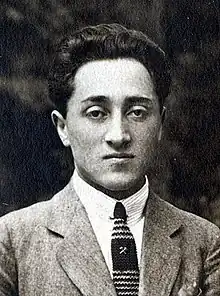
Some students after graduation did not want to return to Soviet Azerbaijan, deciding to stay behind the border and live in exile. Among them is Hilal Munshi, who was sent by the ADR government to study in Germany.[8] Since 1928, he conducted organizational work on the decision of the governing bodies of the Azerbaijani emigration. From 1930 he worked as a technical editor, first at the newspaper "Istiklal" (Independence), and then "Kurtulush" (Salvation). In 1930, Munshi published a brochure about Azerbaijan in German.[9][10] Also established contacts with public groups and the press.[9]
The son of Alimardan bey Topchubashov, Rashid bey Topchubashov, sent to study at the University of Paris, refused the scholarship offered by the Soviet leadership of the country.[11] Topchubashov was the personal secretary of the chairman (Alimardan bey Topchubashov, his father) of the delegation.[12] He died in Paris in 1926.[13]
Abbas Atamalibeyov studied shipbuilding at the Paris University. He was the secretary of the Azerbaijani delegation at the Paris Peace Conference. After completing his studies, he continued his political activities in Paris, graduated from the School of Political Sciences in Paris. After the death of Alimardan bey Topchubashov, he became leaders of Azerbaijani emigrants in France. After the occupation of France by Germany, he lived in Berlin, where he worked in the Committee of the Red Cross and played an important role in rescuing captured Azerbaijani soldiers during the World War II. He was in a group together with Abdurrahman Fatalibeyli and F. Amirjanli), associated with the activities of the Azerbaijani Legion. After World War II he lived in Chile, and in 1967 he moved to the United States, where he died in 1971.
Adil Muganli, who studied at the Faculty of Medicine of Leipzig University, did not return to Azerbaijan. He went to Paris from Berlin in 1923.
Ones who chose to return
Many immigrants from Azerbaijan, after completing their studies, decided to return and start working for their country.[2]
According to researcher Mammad Jafarov's notes, these people, who left independent Azerbaijan and lived in Europe for 5–10 years, began to compare capitalist ways of managing with Soviet ones and came to the idea of the need for a passive or active struggle against the existing system.[2]
Achievements
The graduates of European universities who have returned to their homeland have achieved great success with their work and knowledge. Some of them became directors of factories, heads of oil fields, and executives. Some of them received government awards, including the Order of Lenin.[2]
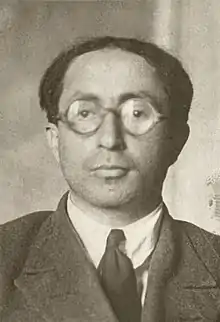
For example, a graduate of the Dresden Polytechnic Institute, Yusuf Agasibeyli, from 1931 worked in Ganja as the chief mechanic at an oil refinery. Graduate of the Mining Institute of Freiburg, Ashraf Aliyev, became the director of the drilling office of the Kaganovichneft, and in 1932 he was awarded the Order of Lenin. Graduate of Prussian Higher Textile Institute (Cottbus), Teymur Aslanov was the director of the textile mill in Ganja.[2] Samandar Akhundov, who also graduated from the Mining Institute of Freiburg, worked as a responsible executive in the heavy industry section of the State Planning Committee of the Azerbaijan SSR. Another graduate, Dinara Kazimova, after returning to Azerbaijan, worked in the country's industry section.[14]
Aslan Vezirzade, a graduate of the Paris Mining Institute, who returned to Baku in 1925, taught at the Azerbaijan Polytechnic Institute, where he was the head of the department of crystallography, mineralogy and petrography, and later was awarded the title of Honored Scientist of the Azerbaijan SSR.[15]
A graduate of the Technical Institute of Darmstadt, Bahram Huseynzade, worked in Ganja as the head of the Electrical Equipment of a textile mill, and later in Baku headed the "Azselelectro" sector at the NKZ of the Azerbaijan SSR.[14] Asildar Muganli, who studied law at the Leipzig University in 1925, returned to Azerbaijan in 1927, worked as a consultant from 1930 to 1933, and later as head of the cash planning group at the Azerbaijan State Bank. Mahish Safarov, a graduate of the Technical Institute of Darmstadt, returned to Azerbaijan in 1926 and worked as a German teacher at the Pedagogical College of the People's Commissariat for Education.[14] Iskenderbek Sultanov, who graduated from the Charlottenburg Polytechnic Institute in 1929, returned to the USSR in 1933 and got a job at the "Electrorazvedka" trust of Azneft.[14]
Some, after returning to Azerbaijan, tried to emigrate back in different ways. Among those who succeeded are the graduates of the Technical Institute of Darmstadt Huseyn Shikhiev and Mamed Efendiyev, who, having arrived in Baku in 1927, left the USSR in 1930. Mirismail Seyidzade, who, after returning from Germany, worked as the chief engineer of Baktramvay, emigrated to Germany with his wife in 1934.[14]
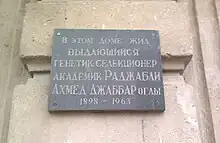
A graduate of the Higher Royal Experimental Agrarian Institute Perugia, Ahmed Rajabli, after returning to Azerbaijan, worked as the director of an agricultural technical school in Zagatala, organized an experimental agricultural station, having achieved the interconnection of these two structures. From 1931 to 1934, Rajabli was the head of the department of southern technical crops of the Azerbaijan Agricultural Institute and, at the same time, a consultant to the People's Commissariat of Agriculture. In 1935, the Higher Attestation Commission in Moscow awarded Rajabli the academic title of professor, he was elected a member of the subtropical crops section of the VASKhNIL, and later became an academician, a member of the Presidium of the Azerbaijan Agricultural Academy.[16]
The father of Togrul and Vidadi Narimanbekov, Farman Narimanbekov, after graduating from the energy faculty of Toulouse University in 1929, returned to Baku and stood at the origins of the construction of the Mingechevir hydroelectric power station.[17]
Repression and rehabilitation
Many of the graduates of Western universities who returned to Azerbaijan were arrested in the 1930s by the NKVD as German "spies" and supporters of the restoration of Azerbaijan's independence.[2] Judging by the analysis of archival materials about the repressed, in the 1930s, citizens of the republic were suspected of dissent and espionage to one degree or another connected with Germany or who knew at least one person of German nationality in Azerbaijan. In all investigative cases, the direction to study in Germany during the ADR years in the records of the NKVD sounded like a crime: "Was sent by the Musavat government to study in Germany"[14]
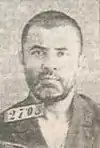
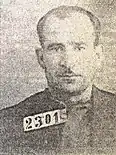
.jpg.webp)
From left to right: Yusuf Agasibeyli, Ashraf Aliyev and Teymur Aslanov
In 1937, Yusuf Agasibeyli was arrested as a member of the Anti-Soviet Insurrectionary Movement. Ashraf Aliyev, arrested in 1936 by the NKVD, was accused of espionage for Germany and anti-Soviet statements. In 1937, he was involved in the second case as an active member of the rebel organization, whose goal was to overthrow Soviet power in Azerbaijan and separate it from the USSR.[2] On 18 October 1937, Teymur Aslanov was arrested, accused of participation in a nationalist rebel organization and espionage activities in favor of German intelligence and sent to a camp in Siberia.[14] Samandar Akhundov was arrested by the GPU in 1933. Bahram Huseynzade, whose wife was a German citizen and was forced to return to her homeland in 1938, was sentenced by the Supreme Court of the USSR to 15 years in prison in 1941 as a member of a nationalist rebel organization and a spy for German intelligence. In 1956, the sentence was overturned for lack of corpus delicti.[14]
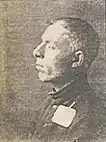

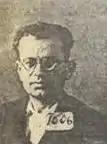
From left to right: Samandar Akhundov, Bahram Huseynzade and Asildar Muganli
Asildar Muganli was arrested because of singing German songs in his house. During interrogation to the statement of the NKVD investigator that the authorities knew that songs were sung in German at Muganly's apartment, Makhish Safarov replied: "Yes, sometimes we sang German songs, but they were not of political content." Muganly was arrested for the first time in 1933, since 1934 he was a teacher of German at universities in Baku, and the second time he was arrested by the NKVD in 1935 and exiled to the Karaganda region. Makhish Safarov was arrested by the NKVD in 1936, and only in 1957, after appealing to the Supreme Court of the USSR with a request to reconsider the case, he was rehabilitated. In 1935, Iskenderbek Sultanov was arrested by the NKVD.[14]
The Bolsheviks repressed not only those whom the ADR government sent to study in Germany, but also citizens sent on a mission in the first years of Sovietization. Among them was Ali Rza Atayev, who graduated from the University of Leipzig, and after returning home in 1925, he went from assistant professor of the Department of Obstetrics and Gynecology of the Azerbaijan Medical Institute to professor and head of the obstetric and gynecological clinic of the Azerbaijan Institute for Advanced Medical Studies, and in 1929 he received Doctor of Medicine degree.[14]
Farman Narimanbekov was also repressed. He was taken away at night directly from the construction site of the Mingechevir hydroelectric power station, where he was then working. After the amnesty, he returned to Mingachevir and was a professional power engineer.[18] On 22 August 1937, breeder Ahmed Rajabli was arrested. He was exiled to one of the numerous camps of the GULAG, Magadan Correctional Labor Camp, and there, in the harsh conditions of Magadan, he created a subsidiary farm, where he bred frost-resistant varieties of vegetable crops. In 1946, he was released and returned home where he continued his research.[16]
Notes
- The photograph was received by Ramiz Abutalibov as a gift from Muhammad Maharramov, a former adviser to the Azerbaijani delegation at the Paris Peace Conference, who once helped young students to settle in Europe.
References
- "Беседы с Рамизом Абуталыбовым: Первые азербайджанские студенты в Европе и Джейхун бек Гаджибейли". 1news.az (in Russian). Archived from the original on 13 April 2010. Retrieved 7 August 2021.
- Jafarov 1998, p. 26.
- Aghamaliyeva, N. (1998). Азербайджанская Демократическая Республика: 1918–1920 (in Russian). Baku: Elm. p. 145. ISBN 978-5-8066-0897-1. Archived from the original on 7 August 2021. Retrieved 7 August 2021.
- Nazarli 2008, p. 177.
- Nazarli 2008, p. 178.
- Nazarli 2008, p. 179.
- Nazarli 2008, p. 180.
- Ramin, Seyid (5 June 2013). "KULIS – "Sevgidən bixəbər kişi"ni Almaniyadan niyə qovdular?". lent.az. Archived from the original on 19 June 2015. Retrieved 9 August 2021.
- Iskhakov, Salavat (2010). Мамед Эмин Расулзаде. Сборник произведений и писем (PDF) (in Russian). Moscow: Flint. p. 194. ISBN 978-5-9765-0814-9. Archived (PDF) from the original on 10 August 2021. Retrieved 10 August 2021.
- Adalet Tahirzade; Ramiz Abutalibov. "Hilal Münşi əsərlərinin ilk nəşri". 525.az. Archived from the original on 19 June 2015. Retrieved 9 August 2021.
- "Azərbaycan Xalq Cümhuriyyəti dövründə xaricə göndərilən tələbələr və onların taleyi barədə qeydlər (əvvəli qəzetin 25 iyul 2012-ci il tarixli sayında)". "Xalq" newspaper. Archived from the original on 5 April 2013. Retrieved 9 August 2021.
- "Topçubaşov ruslara qarşı". dilgamahmad.net. Archived from the original on 8 December 2014.
- Hasanov, Eldaniz (3 August 2014). "Həsən bəy Zərdabinin şəcərəsi ilə bağlı yeni faktlar" (in Azerbaijani). Archived from the original on 3 August 2014. Retrieved 10 August 2021.
- Jafarov 1998, p. 27.
- Соколов Т. Н. (1985). "Отчёт о деятельности Всесоюзного минералогического общества в 1984 г." (Записки Всесоюзного минералогического общества ed.). Общество: 751.
{{cite journal}}: Cite journal requires|journal=(help) - Микеладзе Г. (10 January 2009). "Женщины Азербайджана: "И дольше века длится жизнь"". 1news.az (in Russian). Archived from the original on 12 July 2011.
- "Большая трагедия знать, что нас сменит необразованное поколение – Эсмер Нариманбекова". azeri.ru. 25 May 2012. Archived from the original on 25 May 2012. Retrieved 3 September 2021.
- "Интервью с заслуженной художницей Азербайджана, доцентом Азербайджанской государственной художественной академии Асмер Тогрул гызы Нариманбековой". www.azeri.ru (in Russian). 2 September 2009. Archived from the original on 25 May 2012.
Sources
- Nazarli, Aziza (2008). Народное образование в Азербайджанской Республике (1918–1920 гг.) (PDF) (in Russian). Baku: Nurlan. Archived (PDF) from the original on 8 August 2021. Retrieved 8 August 2021.
- Jafarov, Mammad (1998). "Возвращение на Родину". "Zerkalo" newspaper, №20 (in Russian). Archived from the original on 23 August 2021. Retrieved 8 August 2021.